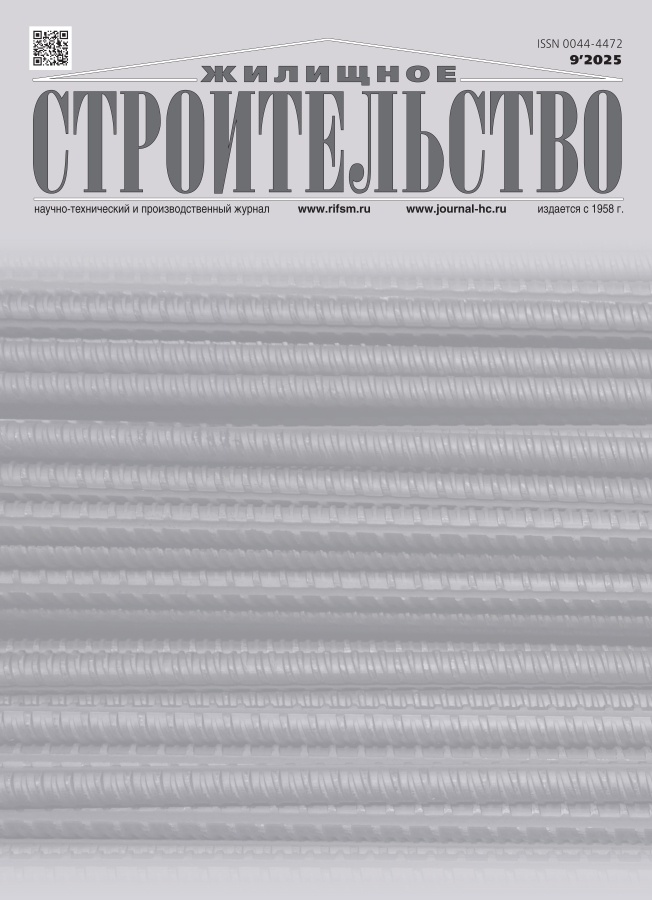Digital assessment of the applicability of regulatory techniques in calculating the aerodynamics of curved surfaces
- Authors: Fursa O.V.1, Khazov P.A.1, Vediaikina O.I.1
-
Affiliations:
- Nizhny Novgorod State University of Architecture and Civil Engineering
- Issue: No 9 (2025)
- Pages: 54-61
- Section: Articles
- URL: https://freezetech.ru/0044-4472/article/view/692960
- DOI: https://doi.org/10.31659/0044-4472-2025-9-54-61
- ID: 692960
Cite item
Abstract
The article is devoted to an in-depth study of modeling patterns of wind flow distribution over a geometrically complex curved surface covering a unique large-span building based on a comparison of two options for performing aerodynamic calculations. The first method consists in conducting a computer experiment on a digital model of the projected object in computational fluid dynamics software systems. The second one is based on the implementation of simplified calculation procedures according to the methods set out in the regulatory documents adopted in the construction industry. When performing a computer experiment, the characteristic features of modeling in the ANSYS CFX software and computing complex are highlighted, such as the construction of a computational model, the formation of a computational grid of finite elements, and the setting of a height-varying wind profile in three of the most relevant directions. Special attention is paid to the correct setting of boundary conditions, which is critical for obtaining reliable results. According to two calculation options, adapted patterns of wind pressure distribution over the curved surface of the building are presented and a comparative analysis of the results is performed, reflecting an excess of wind loads calculated according to regulatory documents by about 1.5–2 times in relation to the data obtained during computer modeling.
Full Text
About the authors
O. V. Fursa
Nizhny Novgorod State University of Architecture and Civil Engineering
Author for correspondence.
Email: olga.fursa2014@yandex.ru
Student
Russian Federation, 65, Ilyinskaya Street, Nizhny Novgorod, 603000P. A. Khazov
Nizhny Novgorod State University of Architecture and Civil Engineering
Email: khazov.nngasu@mail.ru
Candidate of Sciences (Engineering)
Russian Federation, 65, Ilyinskaya Street, Nizhny Novgorod, 603000O. I. Vediaikina
Nizhny Novgorod State University of Architecture and Civil Engineering
Email: razvnauki@rambler.ru
Candidate of Sciences (Physics and Mathematics)
Russian Federation, 65, Ilyinskaya Street, Nizhny Novgorod, 603000References
- Lampsi B.B., Shilov S.S., Khazov P.A. Numerical and physical modeling of wind flows on a large-span coating. Vestnik MGSU. 2022. Vol. 17. Iss. 1, pp. 21–31. (In Russian). EDN: NPDHUS. https://doi.org/10.22227/1997-0935.2022.1.21-31
- Gutnikov V.A., Setuha A.V. Modelirovanie sochetaniya sejsmicheskih i vetrovyh nagruzok pri proektirovanii vysotnyh zdanij. Sejsmostojkoe Stroitel’stvo. Bezopasnost’ Sooruzhenij. 2013. № 4, pp. 24–31. (In Russian). EDN: RARPRX
- Leonovich S.N., Riachi J. 3D-Modeling for life cycle of the structure. Science and Technique. 2021. Vol. 20. No. 1, pp. 5–9. EDN: ORBAPZ. https://doi.org/10.21122/2227-1031-2021-20-1-5-9
- Galishnikova V.V., Bocharov M.E. Information models of construction objects during their life cycle. Real Estate: Economics, Management. 2024. No. 2, pp. 65–72. EDN: UMRISY
- Deineko A.V., Shamshurin A.I., Kazaryan N.A. Selection of the computational model of wind flow in the problems of computational architectural and civil engineering aerodynamics in accordance with regulatory and technical documents. International Journal for Computational Civil and Structural Engineering. 2019. Vol. 15. № 1, pp. 14–28. EDN: ZIFOJF. https://doi.org/10.22337/2587-9618-2019-15-1-14-28
- Olen’kov V.D., Biryukov A.D., Tazeev N.T., Koroteev K.S. Determination of the coefficients of transformation of the air flow when exposed to a single building using computer modeling technologies. Vestnik of the South Ural State University. Construction and Architecture. 2019. Vol. 19. No. 1, pp. 5–13. (In Russian). EDN: YXPLMD. https://doi.org/10.14529/build190101
- Retter E.I. Arkhitekturno-stroitel’naya aerodinamika [Architectural and construction aerodynamics]. Moscow: Stroyizdat. 1984. 294 p.
- Popov N.A., Lebedeva I.V., Bogachev D.S., Berezin M.M. The impact of wind and snow loads on large-span coatings. Promyshlennoe i Grazhdanskoe Stroitel’stvo. 2016. No. 12. pp. 71–76. (In Russian). EDN: XISJCT.
- Belostockij A.M., Pavlov A.S. Calculation of structures of large-span buildings, taking into account physical geometric and structural nonlinearities. International Journal for Computational Civil and Structural Engineering. 2010. Vol. 6. No. 1–2, pp. 80–86. (In Russian). EDN: PZEWHV.
- Poddaeva O. Result verification for numerical modeling of wind effects on unique buildings and structures. Architecture and Engineering. 2024. Vol. 9. No. 2, pp. 79–85. EDN: LYIKLD. https://doi.org/10.23968/2500-0055-2024-9-2-79-85
- Dubinskij S.I., Bolotov P.E. Verification of a computer modeling methodology for calculating air pressure distribution on the outer surface of external enclosing structures. Vestnik MGSU. 2011. No. 7, pp. 276–282. (In Russian). EDN: OWFDZF.
- Belostotsky A.M., Akimov P.A., Afanasyeva I.N. About «Legitimization» of numerical modelling of wind impacts on buildings and structures in design codes. International Journal for Computational Civil and Structural Engineering. 2019. Vol. 15. No. 4, pp. 14–24. EDN: WUSULL. https://doi.org/10.22337/2587-9618-2019-15-4-14-24
Supplementary files























